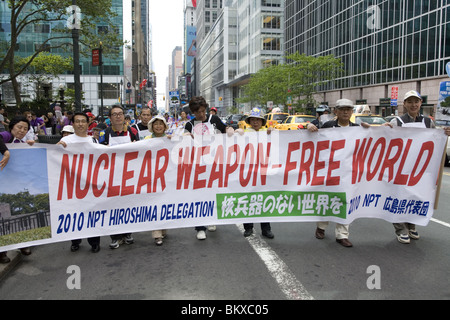
Joe Biden Has Vital Decisions to Make about the Future of America’s Nukes
The Economist
(February 22, 2021) —When the Minuteman III intercontinental ballistic missile (ICBM) entered development, Lyndon Johnson was president, the Vietnam war was in full swing, and the first series of “Star Trek” was on television.
When the missile entered service in 1970, it was cutting-edge. The tip of each one could disgorge three separate warheads, each with a yield ten times higher than that of the bomb dropped on Hiroshima, on three different targets.
More than half a century later, the Minuteman III is America’s last ICBM standing. Four hundred of them are studded in the ground across silos in five mid-western states, ready to blast out and deliver atomic vengeance within minutes of a presidential order.
The Minuteman III is one leg of America’s “nuclear triad,” the suite of silos, submarines and bombers that carry its 1,457 deployed nuclear weapons, within the limit of 1,550 set by the recently extended New START treaty with Russia (more bombs are in storage).
All three legs are getting rusty. The oldest bomber, the B-52, at 66, is old enough to draw a pension; the youngest, the stealthy B-2, was designed in the late 1970s and will retire in a decade or so. The oldest Ohio-class submarine will celebrate its 40th birthday in November.
Replacements for these weapons are on the way. A new bomber, the B-21 “Raider,” will conduct its first flight next year; a new Columbia-class submarine will start prowling the oceans in a decade. Yet the future of the ICBM force is more uncertain. . . . [Read the complete article online.]

US ICBMs Are Superfluous and Increase the Risk of Mistaken Nuclear War, Report Finds
Science Group Calls for Taking Missiles Off Hair-Trigger Alert and Refurbishing Current ICBMs Instead of Building New Ones as First Steps to Elimination
CAMBRIDGE, Mass. (June 22, 2020)—Once considered a vital part of US nuclear deterrence, ground-based intercontinental ballistic missiles (ICBMs) have long been superfluous, according to a report released today by the Union of Concerned Scientists (UCS). The US Air Force keeps the missiles, located in silos in five Plains states, on high alert, increasing the risk that the United States could mistakenly start a nuclear war in response to a false warning of an attack.
“There is no technological rationale for maintaining ICBMs,” said physicist David Wright, report lead author and former co-director of the UCS Global Security Program. “Sixty years ago, ICBMs were more accurate and powerful than submarine-launched ballistic missiles (SLBMs) and communications links with subs were unreliable. Today, SLBMs are as accurate as ICBMs if not more, and the Navy has secure submarine communication links, making the ICBMs unnecessary.
“Perhaps even more important, submarines are virtually undetectable and therefore invulnerable at sea, while ICBMs are sitting ducks. Their vulnerably has prompted the Air Force to keep them on high alert, which is dangerous and could trigger a nuclear war.”
Last week, the Senate Armed Services Committee released a summary of its version of the annual National Defense Authorization Act that suggests it will support an administration request to triple funding for a new generation of ICBMs, from $500 million this year to $1.5 billion in fiscal year 2021, and prohibit taking the current ICBM fleet off high-alert status. Today, the House Armed Services Committee will begin its deliberations over the legislation.
“I want to thank UCS for this report, which I expect will become an invaluable resource as Congress considers the question of whether the United States should spend $100 billion to develop and deploy a suite of new nuclear-armed ICBMs,” said Rep. Ro Khanna (D-Calif.), a member of the House Armed Services Committee. “This is a misguided investment, and I plan to push alternative strategies in Congress to ensure American security without wasting our tax dollars.”
The Air Force maintains the missiles on high alert so it can launch them before they could be destroyed by an incoming Russian nuclear attack. Because it takes only 30 minutes for a long-range missile to travel from Russia to the United States, the president would have only a matter of minutes to decide whether to launch US ICBMs in response without any certainty that the attack warning was accurate.
“A mistaken nuclear launch is a very real possibility,” said physicist Lisbeth Gronlund, a report co-author and former co-director of the UCS Global Security Program. “In fact, there have been a number of close calls over the last 50 years where human or technological errors led both the United States and Russia to begin preparations to launch their nuclear weapons.”

William J. Perry, defense secretary from 1994 to 1997, agrees that the United States could eliminate the ICBM fleet and still have a robust nuclear arsenal.
“Retiring the ICBMs would save considerable costs, but it isn’t only budgets that would benefit,” he wrote in a New York Times column. “These missiles are some of the most dangerous weapons in the world. They could even trigger an accidental nuclear war.” Perry then described a false alarm that he experienced when a computer glitch falsely indicated that there were 200 Soviet nuclear missiles heading toward the United States.
So why does the United States still deploy 400 ICBMs?
The main reasons have nothing to do with national security, the UCS report found. The Air Force wants to retain them for bureaucratic and budgetary reasons. Federal lawmakers want to keep ICBM-related jobs in their states. And defense contractors want a piece of the Ground Based Strategic Deterrent (GBSD) Program to build a fleet of new ICBMs, at an estimated cost of $100 billion. The program is part of a 30-year plan to replace the entire arsenal of nuclear weapons and delivery systems at a cost of more than $1 trillion.
UCS recognizes that retiring the ICBM fleet does not currently have strong political support and is unlikely to happen soon. In the meantime, the report recommended a number of steps the Pentagon should take. They include:
• taking ICBMs off high alert, which can be done easily by turning on the safety switch in each silo;
• eliminating from military plans the option to fire ICBMs in response to an attack—rather than wait for confirmation—which would preclude re-alerting the missiles in a crisis; and
• developing a new warning-assessment and launch-decision process that is not constrained by the 30-minute flight time of a ballistic missile from Russia to the United States.
Finally, even if the Pentagon retains ICBMs for the foreseeable future, the report found that there is no technical reason to build the new GBSD missiles instead of extending the life of the current Minuteman III ICBMs. Maintaining and upgrading Minuteman III ICBMs would be far less expensive than building new missiles.
Official studies have concluded that the Air Force can continue to extend the Minuteman missile’s operational life for decades to come. Using public data, the UCS report also found that past Air Force estimates of rocket lifetimes have been overly conservative and recommended that the Air Force invest in new surveillance methods to improve its ability to assess missile aging.
Posted in accordance with Title 17, Section 107, US Code, for noncommercial, educational purposes.